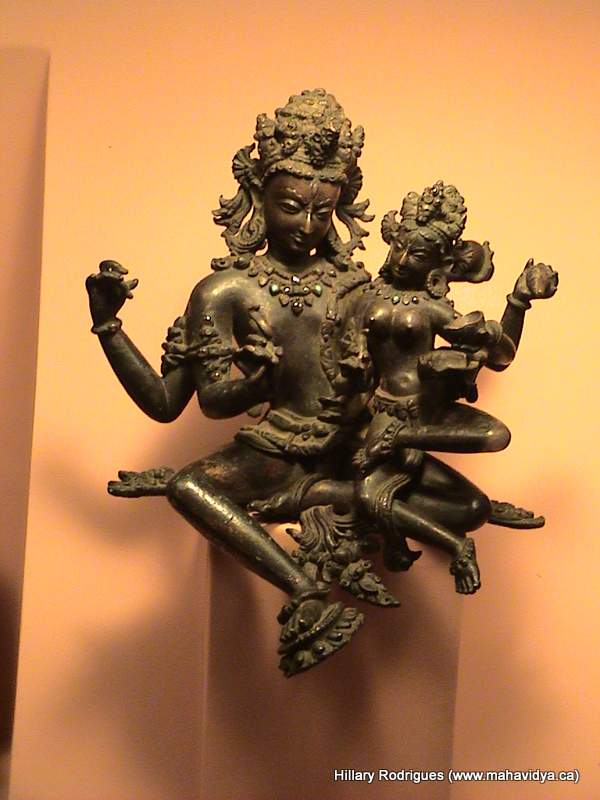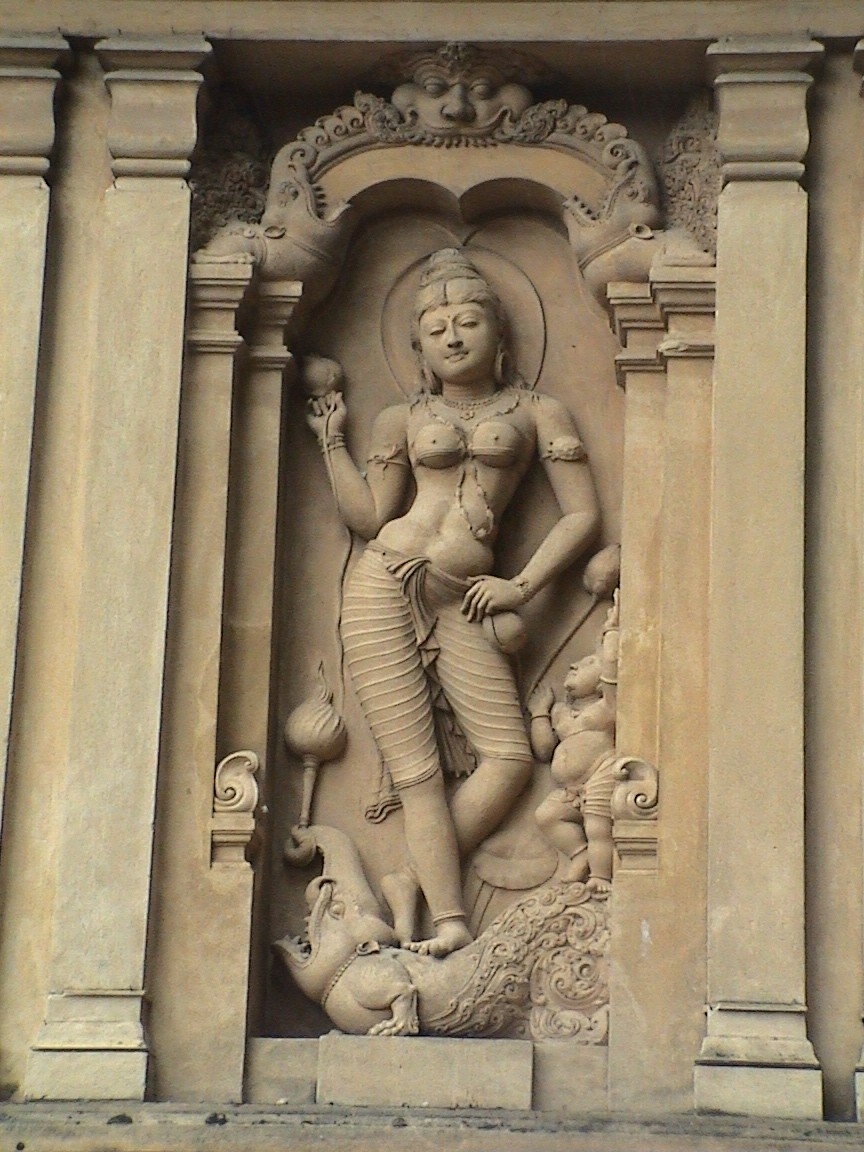When discussing the ten Mahavidyas, it may seem like a daunting task to understand how goddesses, one with a garland of skulls, another with clothing made of severed body parts, and a third with a habit of cutting off her own head, can be highly regarded within the Hindu tradition, but they are. These obscure beings are regarded as being significant to the basic themes of Hindu beliefs and spirituality (Kinsley 1998:1). “It seems that there is logic to the group as a whole and that even its most outrageous members, if understood within their proper context, reveal important spiritual truths” (Kinsley 1998:1). The idea of this group of ten goddesses has been around since the early medieval period (Kamakala-khanda 65-66); specific goddesses within this group even predate this time and continue to be well known in the present day.
The origination of the ten Mahavidyas is not always agreed upon. Some say that the ten Mahavidyas as a whole seem to be “a medieval iconographic and mythological expression of an aspect of Mahadevi theology” (Kinsley 1986:161). There are numerous myths about the Devi in which she is described as producing these goddesses from different parts of her body (Vamana-purana 30.3-9). The Devi is thought to assume these different incarnations in an attempt to maintain cosmic stability (Devi-mahatmya 11.38-50).
“The ten Mahavidyas, at least in part, are probably a Sakta version of the central Vaisnava idea of Visnu’s ten avataras, who appear from time to time to maintain the order of dharma” (Sircar 48). The Guhyatiguhya-tantra confirms this idea by providing a list of the Mahavidyas and associating each one with a corresponding avatara of Visnu (Kinsley 1986:161). However, the ten Mahavidyas are much more than a Sakta representation of Visnu’s avataras; they display significant contrast from the avataras in respect to their appearance and function (Kinsley 1986:161-162).
The context of the story of Sati and Siva is where the true myth of the ten Mahavidyas’ origin arises. Daksa, Sati’s father decides to perform a notable sacrifice and invites every one that resides in the heavenly spheres to attend. That is, everyone aside from his daughter and her husband Siva. Daksa disapproves of Siva’s unkempt appearance and uncivilized behavior and does not want him to taint the legitimacy of the affair (Kinsley 1986:162). Sati is outraged and makes the decision to interrupt the sacrifice, but Siva forbids her to do so. Sati becomes furious, and as she loses her temper, she embodies an appalling form before eventually transforming and multiplying into ten forms, the ten Mahavidyas (Kinsley 1986:162).
Kali, “the black goddess”, is a perfect example of a goddess that is known outside of the goddess cluster. Although the order, names, and number of the Mahavidyas can vary according to different sources, Kali is always included, and is typically named first. Kali is commonly referred to as the most important or primary Mahavidya (Woodroffe 361). In some occurrences, it appears that the rest of the Mahavidyas originate from Kali, or are in some way differing embodiments of her (Kinsley 1998:68). Descriptions of Kali are altered depending on which account is being looked into, but sources tend to agree on several characteristics. Kali is almost always regarded as being a dark presence with a dreadful appearance. She is considered to have four arms, but what they hold are not always agreed upon (Kinsley 1998:67-68). Some sources cite Kali as holding a bloodied cleaver and a severed head in her left hands, while her right hands gesture blessings and a symbol of “fear not” (Kinsley 1998:9). Others say that along with holding a severed head, she carries a jar full of liquor mixed with meat (Kinsley 1998:68). She is commonly regarded as being horrific looking, covered in blood and body parts. Whatever her description, Kali has taken her place as the primary Mahavidya. The Saktisamgama-tantra explicitly says, “All the deities, including the Mahavidyas, Siddhi-vidyas, Vidyas, and Upa-vidyas, are different forms that Kali assumes” (Bhattacharyya & Dvivedi 7-8). Several authorities then view Kali as a symbol of ultimate reality; she truly reveals the nature of fully awakened consciousness (Kinsley 1998:79).
When the Mahavidyas are listed, Tara is typically immediately listed after Kali. This placement would suggest a proposal of importance to the group. Her physical appearance is indeed the most similar to Kali among all the other Mahavidyas; the significance is often interpreted as being comparable to that of Kali. There is a great possibility that the Hindu Mahavidya Tara was developed from the Buddhist bodhisattva Tara, but whereas the Buddhist Tara is often known as being compassionate, the Hindu Tara is almost always fierce, dangerous, and terrible to witness (Kinsley 1998:92). Tara is frequently described as having three bright red eyes. (Kinsley 1998:98). Much like Kali, Tara is often depicted as having a sword and a severed head in her hands; Tara also wears a garland of skulls around her neck (Rai 179-180).
Tripura-sundari is typically listed third, following Kali and Tara in the list of the Mahavidyas. Her name translates to “She who is lovely in the three worlds” (Kinsley 1998:113). She is listed under multiple names, but is also said to be a primary Mahavidya, suggesting that she represents absolute reality. Tripura-sundari’s dhyana mantra portrays her as such: “She shines with the light of the rising sun. In her four hands she hold a noose, a goad, arrows, and a bow” (Unknown 193).
Bhuvanesvari, literally “she whose body is the world”, comes next on the list of the Mahavidyas. Bhuvanesvari is linked with the earth and with creation and is thought to be the underlying energy of it all (Kinsley 1998:131). She embodies the dynamics of the world as we know it. “In this sense…she is identified with the mahabhutas (the basic physical elements) and prakrti (nature or the physical world)” (Kinsley 1998:131). Bhuvanesvari, apart from being included in the Mahavidyas, does not appear to have a widespread following of her own (Kinsley 1998:131).
“The self-decapitated goddess” Chinnamasta is also best known for her involvement in the Mahavidyas, and does not have much of an individual following. Chinnamasta is illustrated holding her own amputated head in one hand, with a sword in the other, drinking her own blood, which is spilling from her neck (Kinsley 1998:144). Although early references to Chinnamasta have not been located, there are accounts of goddesses that are suggested to be prototypes of her, displaying familiar characteristics such as being headless, bloodthirsty, and violent (Kinsley 1998:146).
Bhairavi translates to mean “the fierce one”. She wears red clothing and is adorned with a garland of severed heads; her body is smeared with blood (Kinsley 1998:167). A hymn from the Sarada-tilaka describes Bhairavi as being in a position that oversees and proceeds over the three male deities that are typically associated with creation. She is considered to be separate from the gods and even surpassing them. This emphasis is quite common in many hymns regarding goddesses, especially in the cases pertaining to the Mahavidyas (Kinsley 1998:169). Bhairavi also assumes the role of an educator and creates the Vedas through her wisdom (Kinsley 1998:169).
Dhumavati is known as the widow goddess. She is typically depicted as being ugly, upset, and disheveled; her hands shake and her eyes are full of concern (Kinsley 1998:176). She symbolizes the painful and more burdensome aspects of life (Kinsley 1998:181). Outside of the Mahavidyas, virtually nothing is known about Dhumavati.
Bagalamukhi can be referred to as “the paralyzer”. She emits a grim disposition and is heavily intoxicated. Her complexion is completely golden, embellished by her yellow dress, ornaments, and garland (Kinsley 1998:193). Bagalamukhi is associated with having magical powers. Her devotees are said to reap the rewards of her powers (Kinsley 1998:199-200).

Matangi is considered to be the “outcaste” among the other goddesses within this cluster. A particular myth pertaining to Matangi touches on the idea of being polluted by associating with the Candalas, or “the untouchables” (Kinsley 1998:217).
Kamala, the final goddess of the Mahavidyas, is known as “the lotus goddess” (Kinsley 1998:223). Kamala is none other than the goddess Laksmi. Among all of the goddesses included in the ten Mahavidyas, Kamala is the most popular and well known. She is “a goddess with almost completely auspicious, benign, and desirable qualities” (Kinsley 1998:225). Kamala is often identified with a variety of blessings that humans ordinarily seek, such as power, luck, wealth, and safety (Kinsley 1998:225).
Even though a couple of the goddesses are presented as being beautiful and harmless, the context of their origin myth makes it evident that the ten Mahavidyas are intended to be fearsome deities. Their main objective in the myth is to scare Siva into letting Sita have her way (Kinsley 1986:163-164). This overpowering embodiment displays Sita’s assertion of power, suggesting a sense of superiority (Kinsley 1986:164). In both the Brhaddharma-purana and the Mahabhagavata-purana it is suggested that Sati appears in these forms to allow her devotees to achieve ultimate realization (moksa), and so that they may achieve their desires (Kinsley 1986:164).
The ten Mahavidyas are powerful and relevant as a group, but individually, only a select few can stand on their own and parade a widespread individual following. These primary Mahavidyas personify the concept of absolute reality and complete consciousness, which is at the heart of the Hindu tradition.
REFERENCES AND FURTHER RECOMMENDED READING
Bhattacharyya, B. and Dvivdei, Vrajavallabha (1978) Saktisamgama-tantra. Baroda: Oriental Institute of Baroda.
Gupta, Anand S. (1968) Vamana-purana. Banaras: All-India Kashiraj Trust.
Kamakala-khanda (1974) Mahakala-samhita. Allahabad: Ganganath Jha Research Institute.
Kinsley, David (1986) Hindu Goddesses: Visions of the Divine Feminine in the Hindu Religious Tradition. Berkeley: University of California Press.
Kinsley, David (1998) Tantric Visions of the Divine Feminine. Delhi: University of California Press.
Rai, R. Kumar (1992) Mantra Mahodadhih. Varanasi: Prachya Prakashan.
Shankaranarayanan, S (1972) The Ten Great Cosmic Powers (Dasa Mahavidyas). Dipti Publications.
Sircar, D.C. (1973) The Sakta Pithas. Delhi: Motilal Banarsidass.
Vasudeva, S.A. (1963) Devi-mahatmya; The Glorification of the Great Goddess. Banaras: All-India Kashiraj Trust.
Woodroffe, Sir John (1987) Sakti and Sakta, Essays and Addresses. Madras: Ganesh & Co..
Related Topics for Further Investigation
Tantric worship
Kali
Tara
Tripura-sundari
Bhuvanesvari
Chinnamasta
Chairavi
Dhumavati
Bagalamukhi
Matangi
Kamala
Severed heads
Cremation grounds
Role of women
Absolute reality
Magical powers
Noteworthy Websites Related to the Topic
www.rudraksha-ratna.com/mahavidyas.html
www.en.wikipedia.org/wiki/Mahavidya
www.exoticindiaart.com/article/mahavidyas
Article written by: Jamie Hancock (April 2010) who is solely responsible for its content.










